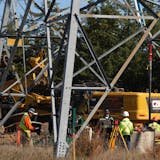It's tough to be a moose in Minnesota.
The deaths of 54 that were tracked as part of the biggest and most high-tech research study ever conducted on moose provide a rare glimpse into the harsh life they face in the wild and help explain why they are rapidly disappearing from Minnesota's North Woods.
By far the greatest number, primarily calves, were killed by bears and wolves. A number were abandoned by their mothers; one drowned. Three adults died from massive infestations of winter ticks, and others succumbed to deer-related parasites and infections.
Researchers said one season's worth of data from about 150 collared moose is not enough to illuminate trends or to provide solutions in how to help them rebound. But it's clear, they said, that more are dying than is normal.
Calves suffered a 71 percent mortality rate after only one summer, said Glenn DelGiudice, the wildlife researcher for the Minnesota Department of Natural Resources who is running the calf research portion of the study.
And the ones that made it so far still have to survive their first winter.
Moose need a mortality rate of 50 or 55 percent in the first year of life to maintain their population, DelGiudice said.
The adult death rate was 18 percent, said Michelle Carstensen, who is running the adult research for DNR. If that rises to 30 percent in the winter, as expected, "that's not sustainable," she said.


